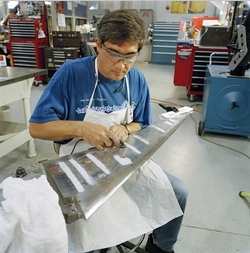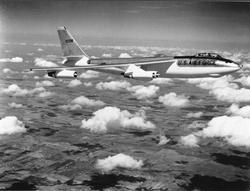Low-speed wind-tunnel tests have started for the Boeing 7E7, and
work is nearly complete on the model that will be used in a first
round of high-speed wind-tunnel tests for the new airplane.
 Wind-tunnel models allow experts to test many
different configurations for the proposed airplane. Low-speed tests
measure airplane performance with a variety of high-lift surface
settings to simulate takeoff and landing conditions.
Wind-tunnel models allow experts to test many
different configurations for the proposed airplane. Low-speed tests
measure airplane performance with a variety of high-lift surface
settings to simulate takeoff and landing conditions.
During the first round of high-speed tests Boeing will test four
distinctly different wing designs at the Boeing Transonic Wind
Tunnel in Seattle (WA). Each wing has its own unique features
ranging in size, sweep and design details.
 "On the 767 program, we performed wind-tunnel
tests with more than 50 different wing configurations," said Mike
Bair, senior vice president of the 7E7 program. "On this program,
we likely will test no more than a dozen."
"On the 767 program, we performed wind-tunnel
tests with more than 50 different wing configurations," said Mike
Bair, senior vice president of the 7E7 program. "On this program,
we likely will test no more than a dozen."
Fewer tests are needed today because modern computational fluid
dynamics (CFD) tools allow designers to consider and run virtual
experiments on designs with a higher degree of confidence than ever
before. Only those designs that show real promise will make it to
the wind tunnel.
"Our computer modeling tools allow us to predict much more
closely what will transpire in the wind tunnel, which then
accurately verifies the flight performance of the airplane," Bair
said. "This process gives us the opportunity to refine our designs
with computers long before we ever get to the wind tunnel. We are
looking for the design that will allow the airplane to fly most
efficiently."
Hundreds of sensors are embedded in the model to measure
pressure to determine the in-flight loads as well as provide
valuable diagnostics of the aerodynamic performance of a given
design. These measured pressures also help calibrate the CFD tools
to make them even more accurate.
The results of the first round of tests will give designers
confidence in the aerodynamic performance levels they seek on the
7E7. Subsequent test rounds will provide further design refinement
and more accurate airplane performance predictions. Two additional
rounds of low-speed and high-speed testing will be conducted during
the development of the 7E7. Also, wind-tunnel tests for noise,
icing, flutter and propulsion are scheduled through early 2006.
"We know a lot about our new airplanes before they are ever
flown, through core competencies of computational fluid dynamics
and wind-tunnel testing," Bair said. "It’s why we can be
confident in the safety and integrity of the first airplane and
every airplane that follows."
Model Making
 It takes nearly four months to build a wind-tunnel
model. The high-speed model currently in development will be a
3.9-percent scale model of the baseline 7E7, measuring about 2.2
meters (88 inches) long with a wing span of 2.2 meters (88
inches).
It takes nearly four months to build a wind-tunnel
model. The high-speed model currently in development will be a
3.9-percent scale model of the baseline 7E7, measuring about 2.2
meters (88 inches) long with a wing span of 2.2 meters (88
inches).
Boeing model design engineers create the high-speed model using
CATIA, a sophisticated CAD/CAM program. Programmers use the CATIA
model to create Numerical Control programs that help fabricate the
airplane on computer-controlled milling machines. Because of the
small scale of the model and the need to be very precise --
tolerances are often within 0.15 millimeters (0.006 inches) -- much
of the model is created by hand.
"Building wind-tunnel models is a unique skill," Bair said. "Our
model designers and machinists take great pride in their work and
are among the most skilled in the world."
Boeing Transonic Wind-Tunnel Background
 The Boeing
Transonic Wind Tunnel, originally opened in 1944 for testing of the
B-47 (right), has undergone dramatic upgrades in the last five
years. The changes include a new drive system with a
55,000-horsepower variable speed motor. Tunnel environment and air
quality in the test section were improved with a circuit extension
and the addition of a full-flow heat exchanger and dehumidifier
system. In addition, redesigned fan blades have been installed
along with new turning vanes, a flow conditioner and a bell mouth.
A variety of model measurement methods and data acquisition
equipment are selectively available.
The Boeing
Transonic Wind Tunnel, originally opened in 1944 for testing of the
B-47 (right), has undergone dramatic upgrades in the last five
years. The changes include a new drive system with a
55,000-horsepower variable speed motor. Tunnel environment and air
quality in the test section were improved with a circuit extension
and the addition of a full-flow heat exchanger and dehumidifier
system. In addition, redesigned fan blades have been installed
along with new turning vanes, a flow conditioner and a bell mouth.
A variety of model measurement methods and data acquisition
equipment are selectively available.
The changes make the Boeing Transonic Wind Tunnel a
state-of-the-art facility, ready to provide service for the second
century of flight.
 ANN's Daily Aero-Term (12.13.25): Light Gun
ANN's Daily Aero-Term (12.13.25): Light Gun Aero-News: Quote of the Day (12.13.25)
Aero-News: Quote of the Day (12.13.25) NTSB Final Report: Gippsland GA-8
NTSB Final Report: Gippsland GA-8 Classic Aero-TV: Historically Unique -- Marlin Horst's Exquisite Fairchild 71
Classic Aero-TV: Historically Unique -- Marlin Horst's Exquisite Fairchild 71 Airborne 12.12.25: Global 8000, Korea Pilot Honors, AV-30 Update
Airborne 12.12.25: Global 8000, Korea Pilot Honors, AV-30 Update






